|
The Metropolitan
Railway
In 1899 Thomas Parker became Consulting
Electrical Engineer to the Metropolitan Railway Company. He was
responsible for electrification of the Metropolitan system. An
experimental electric locomotive was constructed and it ran for the
first time in October 1899, as is reported in the following article: |
|
The Midland Evening News. Wednesday, 25th October,
1899
The Metropolitan Railway and Electricity
Yesterday an important stage was reached in
the scheme which has been adopted by the Metropolitan Railway
Company for substituting electricity for steam on their line, so
much of which runs underneath London. An experimental electric
train for carrying passengers has just been constructed at the
company’s works at Neasden. This train has been designed and
built under the supervision of our able townsman, Mr. Thomas
Parker, J.P., who holds the position of consulting electrical
engineer to the Metropolitan Railway Company. Yesterday the
directors inspected the train, at Wembley Park, and made a trial
with it. They expressed themselves as entirely satisfied, and
similar trains will now be built for the Metropolitan system. It
is said that the substitution of electric trains will cost the
company a million sterling. |
|
| After the success of the trial, tenders were sent
to prospective manufacturers, as can be seen from the following
report: |
|
Birmingham Evening Post.
21st November, 1900
A £5,000,000 Railway Order
Sir William Preece, Consulting Engineer for the Metropolitan
Underground Railway Company described the competition for the
electrification of the line as “An international battle of brains
for £5,000,000.” The tenders for the undertaking will be opened on
December 1st; over 50 miles of line are involved the cost
of changing to electric traction is estimated to exceed £5,000,000.
Tenders for the work have been
invited from America, Germany, France and Great Britain. The
American bidders are the Thompson Houston Company and the
Westinghouse Company, both of which are confident that they will get
the contract. England is represented in the bidding by Mather and
Platt, The Brush Electric Company, Crompton and Co., Thomas Parker,
Ltd., and Dick, Kerr & Co. The German bidders are Allgemeine
Electrikstst Gesellschaft, Siemens Brothers, Schlukert and Co., and
Felten and Guilleaume. The French bidders are the Bregguet Electique
Company, M.M. Houtin and Le Blanc. It is rumoured says the “Express”
that the lack of specifications has led to certain difficulties
which may necessitate the reopening of the contest under fixed
conditions after the present tenders have been opened and studied. |
|
| After reading the above report, Thomas Parker
replied in the following letter: |
|
To the Editor of the “Midland Evening News”.
Sir, My attention has been called to a
paragraph in this morning’s “Birmingham Evening Post”, quoted
from the London “Express”, and purporting to be inspired by Sir
William Preece. It is possible Sir William may have made some
remarks upon this matter, but evidently the interviewer has
drawn largely upon his own imagination, as Sir William would not
make any statement with regard to the amount of contracts,
anticipating the tenders to be sent in by manufacturers.
The paragraph also states that Thomas Parker,
Limited, are tenderers for this work. This is untrue; nor would
Sir William make such a reference as to there being the
likelihood of “re-opening the contest” after the 1st
December.
The London “Express” evidently does not
comprehend the whole situation that there are two companies
involved, the “Metropolitan and District Railway” and the
“Metropolitan Railway”.
It is true that tenders have been asked for,
and a number of firms including American, German, English,
French and others, are sending in tenders which will be opened
on 1st
December, and these will be dealt with as expeditiously as
possible, the railway companies being anxious to make the change
from steam to electric driving as quickly as possible. To this
end they have been working now for over a year.
Yours faithfully
Thomas Parker
Electrical Engineer to the Metropolitan Railway Company
Wolverhampton |
|
| The District Railway Company were also about to
electrify their line and it was in everyone's interest for the two
companies to adopt the same system. The Metropolitan Railway
favoured the A.C. system and the District Company preferred the D.C.
system.
A tribunal was set up under the Metropolitan District Railway
Act, 1901, to hear evidence and to report to the Board of Trade,
on which system should be adopted. The Hon. Alfred Lyttleton,
K.C., M.P., was appointed as arbiter. The members of the
tribunal were Thomas Parker, nominated by the Metropolitan
Railway Company and Mr. H.F. Parshall, engineer, of 8 Prince
Street, London, E.C., nominated by the District Company. They
heard the evidence of the two parties, and the arguments and
speeches of the counsel on their behalf, on 7th
October and eleven subsequent days. |
|
Midland Evening News. Monday, 16th September, 1901
The Underground Railway Deadlock
The Board of Trade have appointed
the Hon. Alfred Lyttleton, K.C., M.P., as arbiter between the
Metropolitan District Railway Companies on the question of the
system to be adopted for the establishment of electric traction on
the railways of the two companies. The District Company will be
represented by Mr. Parshall, electrical engineer, who installed the
Central London Railway, and executed commissions for the Glasgow and
other corporations. Mr. T. Parker will state the case for the
Metropolitan Company. The tribunal will meet almost immediately, and
a satisfactory result is expected in a few weeks.
|
|
| A decision was soon reached, and this was reported
in the Financial Times of 14th November, 1901. |
|
The Honourable Alfred Lyttelton, arbitrator
in the matter of the electrification of the Metropolitan and
Metropolitan District railways made a decision in favour of the
“Yerkes” system as against the “Ganz” system to the Board of
Trade. The Metropolitan Railway Company owns 9 miles of track
and the District Railway Company owns 4 miles of track, both of
which form the Inner Circle. Both companies are also joint
owners of the City Line and Extension Railways.
The “Yerkes” or continuous system uses a high
A.C. voltage which is distributed, and at suitable sub-stations
is reduced by a transformer and rectified by a rotary converter,
to provide 600 Volts D.C., which is connected to a third rail.
This system is well tried and tested and already in use on many
railways. The alternating system, developed by Ganz and Company
of Budapest, proposed the use of an overhead conductor supplied
with 3,000 Volts A.C. At the time the maximum voltage used on a
railway was 750 Volts and so there was some uncertainty about
the use of such a high voltage.
|
|
| In 1904 Thomas was awarded two gold
medals by the Smoke Abatement Society, for his work on combating air
pollution. The first was for his invention of the "Kyrle" fire grate
and the second for his invention of "Coalite", the smokeless fuel.
In the same year he resigned from his position
as director of Thomas Parker, Limited and moved to London, after
being invited to join the Board of Directors of the Metropolitan
Railway Company. Thomas and Jane acquired a house in
Hampstead. His move to London was reported in
the May 1904 edition of the Wolverhampton Journal:
|
| Mr. Thomas Parker, J.P., has resigned his
position as director of Thomas Parker, Ltd., and Mr. James
Underhill has been elected to succeed him. Mr. Parker is
about to take up his residence in London, where he is
engaged as consulting electrical engineer to the
Metropolitan Railway Company. He has charge of the
conversion of the Metropolitan system from steam to
electricity. Mr. Parker has had many years connection with
Wolverhampton, and his departure will be generally
regretted. |
|
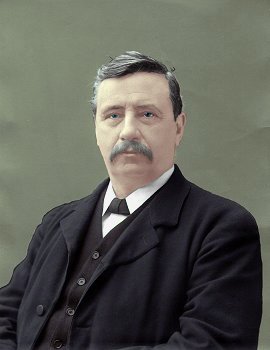
A hand-tinted photograph of Thomas, which gives
a good impression of how he looked in middle age. |
Thomas did not break all of his links with the town, as
can be seen from this mention in a later edition of the Wolverhampton
Journal:
|
11th November 1904
Mount Zion Chapel
A three days’ Bazaar and Grecian
Festival opened by Mr. T. Parker, J.P. |
|
Work on the new system progressed rapidly and the first passenger
carrying electric-powered trains were running in 1905.
The following
description of the first run, was written by
Mr. E. J. Chambers, who
was writing from Thomas's last house in Wolverhampton, so presumably
he purchased the Manor House from the Parkers when they moved to
London. |
|
The Midland Evening News. Wednesday, 22nd March, 1905
New Underground
Mr. E. J. Chambers describes the first run
The Metropolitan Railway Company
has now completed the electrification of its entire system. On
Monday the last steam train vanished from Baker Street to the
Uxbridge section.
Within a short period electric
trains will be running on the Metropolitan section of the Inner
Circle, although owing to the delay of the District Railway in
completing its plans, the new trains will not yet be able to run
over the full circle.
The first trip of a fully equipped
electric train upon any portion of the circle was made in the early
hours of yesterday morning. The train was taken from the depot at
Neasden, via Baker Street, to South Kensington, and from there made
the journey to Aldgate and back, travelling every portion of the
Metropolitan Railway Company’s section of the Inner Circle.
Mr. E. J. Chambers of Manor
House, Tettenhall, writes:
Through the courtesy of the
General Manager, Mr. A. C. Ellis, I obtained permission to join the
party for the first trip of the electric train over that portion of
the circle belonging to the company, and while the majority of your
readers were sleeping the sleep of the just, I started on my
midnight adventure.
My friends at the hotel cast
sidelong glances at me as I sallied forth at the witching hour,
evidently thinking that another good man had gone wrong. Arrived at
Baker Street Station, I found myself surrounded by the Argus-eyed
representatives of the press, all the electrical talent of the
enterprising railway company, the general manager, almost
ubiquitous, and our old townsman “Honest Tom”, the consulting
electrical engineer, with his able and efficient staff, all bent on
making the trip a success.
Little do the public who
thoughtlessly make use of the good provided for them, dream of the
enormous amount of thought and care devoted to their service; of the
army of officers and men who work con amore to make that service
worthy of a place in history.
An Invincible Power
“All Aboard” meets with a ready
response, and as soon as the line is signalled clear we glide out of
the station, bound for South Kensington. No puffing and snorting of
the “loco” to distract our attention; no cloud of steam to wrap us
in its clammy embrace; no smoke to half asphyxiate. No, we journey
on; we move as if by an invisible power, and, indeed, it is
invisible, but none the less existent.
Far away, at the power station at
Neasden, gigantic steam turbines are doing their work, generating an
alternating current equal to a pressure of 11,000 volts, alternating
down to 400 volts, which is then converted by transformer to a
continuous current of 600 volts, and this current actuates the
motors attached to the leading and trailing cars of the train.
Each of these cars has four
motors, which together give out 600 horsepower, making a total of
1,200 horsepower for each train, the motors running at from 800 to
900 revolutions per minute, four intermediate cars without motors
making up the train. Four hundred passengers can be accommodated
with seats.
Splendidly lighted, ample space,
fireproof carriages, elegant in design, and, above all comfortable.
What more can the travelling public desire?
We passed the station on route at
a speed that would astonish our ancestors, and reached South
Kensington without a hitch. After a halt of a few minutes we started
on our return journey, and made time back through Baker Street on to
Aldgate, and visions of the Bull at Aldgate arose in our minds, but
the thoughtful general manager had even anticipated this, and we
were regaled with the good things of life to our heart’s content. We
started for home at a pace that ought to satisfy even a
Wolverhampton motorist. Baker Street once more, and cab to hotel,
3.30a.m.; explanations to hall porter, received after the manner of
hall porters, and we are glad to seek repose.
|
|
|
In 1907 Thomas wrote a detailed technical evaluation of the
electrification of the Metropolitan Railway. It appeared in 'The
Engineer' on 1st March, 1907.
| |
|
| Read Thomas's
evaluation of the electrification of the railway. It is
extremely technical in nature. |
 |
| |
|
Neasden Power Station was
built in 1904 by the Metropolitan Railway for their
electrification project. It opened in December 1904. The Neasden
site was alongside the Metropolitan Railway's depot and
workshops. Coal for the power station was brought in by rail.
Four turbo-generator sets were installed, served by 14
water-tube boilers, worked at up to 185lb. pressure. The
turbines were of the "Westinghouse-Parsons" pattern, each of
3,500 kilowatts normal power, and capable of 50 per cent
overload for one hour. There was a daily momentary peak in the
use of each of them of about 100 per cent overload. They ran at
1,000 revolutions per minute.
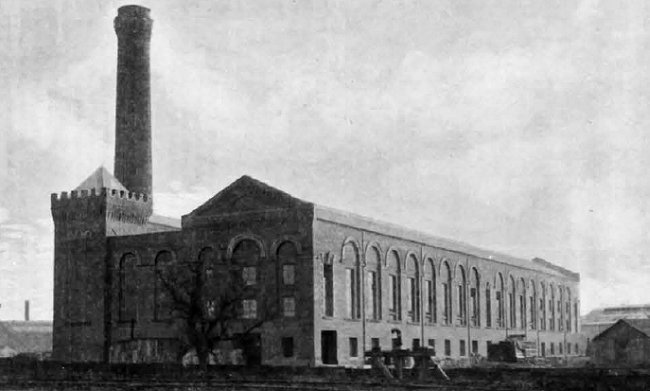
Neasden Power Station. From The Engineer,
12th February, 1904.
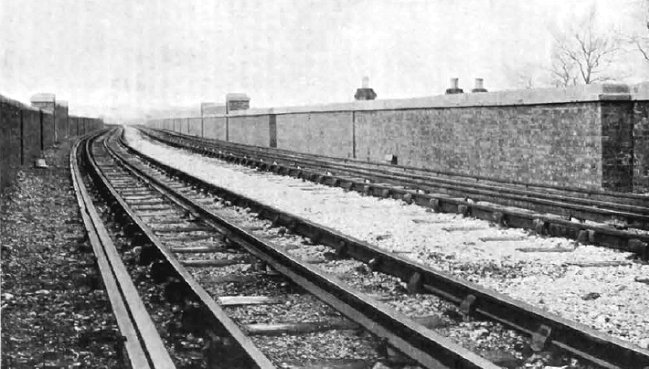
The permanent way. From The Engineer, 12th
February, 1904.
The three phase alternators
provided 11,000 volts in each phase at a frequency of 83 cycles
per second; there was also a small 100 kilowatt alternator to
supply power to various small motors and for lighting the
station and yards. The feeders were three-core, paper insulated,
with a lead sheath, and steel armoured. Three of the largest
size led to Baker street sub-station, which was the distributing
centre for the Circle Line substations, and two each of a
smaller size led from Neasden to Harrow and Ruislip. Of the 9
substations, most had three 800 kilowatt rotary converters each,
but Charlton Street and Moorgate Street stations each had three
1,200 kilowatt converters. Baker Street station had four 1,200
kilowatt rotaries. In all there were 28 substation rotaries, of
total capacity 25,200 kilowatts. Each converter was served by 3
static transformers reducing from 11,000 to about 440 volts.
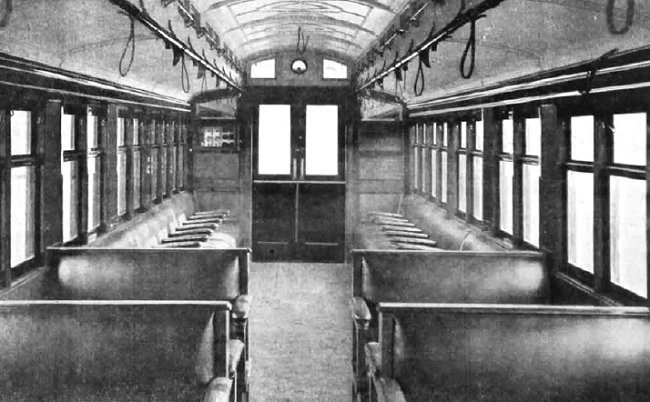
Coach interior. From The Engineer, 12th
February, 1904.
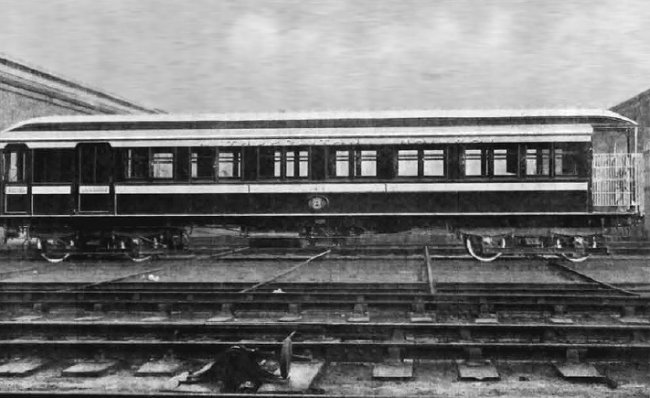
Motor coach. From The Engineer, 12th
February, 1904.
In 1924 new equipment for the
power station was supplied by GEC, and from 1933 Neasden and
Lots Road Power Station supplied the London Transport network.
In 1968 The power station ceased generating.
Thomas Parker stayed in London until his retirement in 1908,
when the Parker family returned to Coalbrookdale for the last time.
 |
|
 |
|
 |
Return
to
Thomas Parker Ltd. |
|
Return
to the beginning |
|
Proceed to
Weights, Measures |
|
|